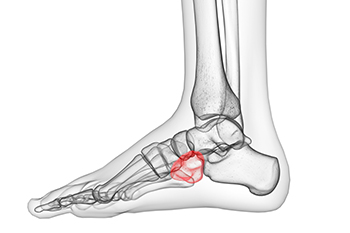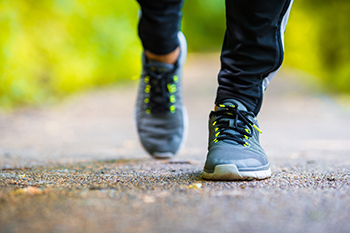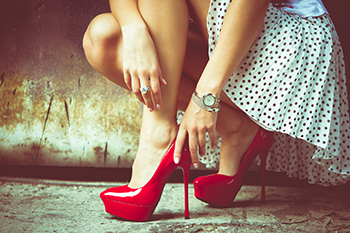Items filtered by date: January 2023
What Can Cause Cuboid Syndrome?

Patients who have pain on the outside of their feet may have developed cuboid syndrome. This condition can happen by incurring an injury that affects the cuboid bone. This bone is one of seven tarsal bones that connect to the toes and heel and contributes to a normal gait or walking style. Cuboid syndrome may be prevalent among runners and ballet dancers due to its repetitive impact. Additionally, it may occur in people who run on uneven surfaces or wear shoes that do not have adequate support. The common symptoms that are experienced can include ankle pain that is sudden or gradual, and the entire foot may be tender or sore. An X-ray can help rule out a fracture. Typically, the activity that caused the pain must be stopped and the affected foot should be elevated as often as possible. The healing process may be accelerated when non-impact exercises are performed as this can help strengthen the entire foot. If you have pain along the outside of your foot please consult a podiatrist who can determine if cuboid syndrome is the cause as well as provide effective treatment techniques.
Cuboid syndrome, also known as cuboid subluxation, occurs when the joints and ligaments near the cuboid bone in the foot become torn. If you have cuboid syndrome, consult with one of our podiatrists from Dr. Jeffrey J. Betman & Associates . Our doctors will assess your condition and provide you with quality foot and ankle treatment.
Cuboid syndrome is a common cause of lateral foot pain, which is pain on the outside of the foot. The condition may happen suddenly due to an ankle sprain, or it may develop slowly overtime from repetitive tension through the bone and surrounding structures.
Causes
The most common causes of cuboid syndrome include:
- Injury – The most common cause of this ailment is an ankle sprain.
- Repetitive Strain – Tension placed through the peroneus longus muscle from repetitive activities such as jumping and running may cause excessive traction on the bone causing it to sublux.
- Altered Foot Biomechanics – Most people suffering from cuboid subluxation have flat feet.
Symptoms
A common symptom of cuboid syndrome is pain along the outside of the foot which can be felt in the ankle and toes. This pain may create walking difficulties and may cause those with the condition to walk with a limp.
Diagnosis
Diagnosis of cuboid syndrome is often difficult, and it is often misdiagnosed. X-rays, MRIs and CT scans often fail to properly show the cuboid subluxation. Although there isn’t a specific test used to diagnose cuboid syndrome, your podiatrist will usually check if pain is felt while pressing firmly on the cuboid bone of your foot.
Treatment
Just as the range of causes varies widely, so do treatments. Some more common treatments are ice therapy, rest, exercise, taping, and orthotics.
If you have any questions, please feel free to contact our offices located in Northwest Chicago, Southwest Chicago, and Wicker Park, Chicago, IL . We offer the newest diagnostic and treatment technologies for all your foot care needs.
What Causes Plantar Fasciitis?

There is a portion of tissue on the bottom of the foot that is called the plantar fascia. It connects the heel to the toes and is instrumental in helping the foot flex while walking, running, and completing other daily activities. An injury may cause the plantar fascia to tear, possibly resulting in plantar fasciitis. It may also occur from overuse that can happen from running or standing on uneven surfaces. Plantar fasciitis is an inflammation that can cause severe pain and discomfort, and may affect the Achilles tendon in the calf. It may also be caused by wearing shoes that do not fit correctly, having an abnormal foot structure, or from weight that has been gained. Common symptoms may include foot pain after sitting or standing for a long period of time, and difficulty in climbing the steps. Additionally, the pain may be more severe after arising in the morning, as the first few steps are taken. If you have foot pain, it is strongly urged that you are under the care of a podiatrist who can accurately diagnose plantar fasciitis, and guide you toward the correct treatment techniques.
Plantar fasciitis is a common foot condition that is often caused by a strain injury. If you are experiencing heel pain or symptoms of plantar fasciitis, contact one of our podiatrists from Dr. Jeffrey J. Betman & Associates . Our doctors can provide the care you need to keep you pain-free and on your feet.
What Is Plantar Fasciitis?
Plantar fasciitis is one of the most common causes of heel pain. The plantar fascia is a ligament that connects your heel to the front of your foot. When this ligament becomes inflamed, plantar fasciitis is the result. If you have plantar fasciitis you will have a stabbing pain that usually occurs with your first steps in the morning. As the day progresses and you walk around more, this pain will start to disappear, but it will return after long periods of standing or sitting.
What Causes Plantar Fasciitis?
- Excessive running
- Having high arches in your feet
- Other foot issues such as flat feet
- Pregnancy (due to the sudden weight gain)
- Being on your feet very often
There are some risk factors that may make you more likely to develop plantar fasciitis compared to others. The condition most commonly affects adults between the ages of 40 and 60. It also tends to affect people who are obese because the extra pounds result in extra stress being placed on the plantar fascia.
Prevention
- Take good care of your feet – Wear shoes that have good arch support and heel cushioning.
- Maintain a healthy weight
- If you are a runner, alternate running with other sports that won’t cause heel pain
There are a variety of treatment options available for plantar fasciitis along with the pain that accompanies it. Additionally, physical therapy is a very important component in the treatment process. It is important that you meet with your podiatrist to determine which treatment option is best for you.
If you have any questions, please feel free to contact our offices located in Northwest Chicago, Southwest Chicago, and Wicker Park, Chicago, IL . We offer the newest diagnostic and treatment technologies for all your foot care needs.
What Does a Plantar Wart Look Like?

As painful as a plantar wart can be, it is considered to be a harmless skin growth. It is a small area of hardened skin that is sometimes filled with black dots, which are blood vessels. It is caused by a fungus and develops on the sole of the foot. It generally grows inward as a result of the pressure the bottom of the foot endures from body weight. Many people experience extreme discomfort with a plantar wart and often look for prompt medical attention for relief. They are considered to be contagious, and it is beneficial to refrain from sharing towels, shoes, and socks. Medicine may be prescribed that can freeze the wart, or for stubborn plantar warts, surgery may be necessary for removal. It is beneficial to choose shoes that are comfortable, and avoid wearing any type of shoe that puts pressure on the heels. Some patients find it helpful to put a protective covering over the wart which may help to ease the pressure that is felt from walking. If you have developed a plantar wart, it is strongly urged that you are under the care of a podiatrist who can guide you toward the necessary treatment.
Plantar warts can be very uncomfortable. If you need your feet checked, contact one of our podiatrists from Dr. Jeffrey J. Betman & Associates . Our doctors will assist you with all of your foot and ankle needs.
About Plantar Warts
Plantar warts are the result of HPV, or human papillomavirus, getting into open wounds on the feet. They are mostly found on the heels or balls of the feet.
While plantar warts are generally harmless, those experiencing excessive pain or those suffering from diabetes or a compromised immune system require immediate medical care. Plantar warts are easily diagnosed, usually through scraping off a bit of rough skin or by getting a biopsy.
Symptoms
- Lesions on the bottom of your feet, usually rough and grainy
- Hard or thick callused spots
- Wart seeds, which are small clotted blood vessels that look like little black spots
- Pain, discomfort, or tenderness of your feet when walking or standing
Treatment
- Freezing
- Electric tool removal
- Laser Treatment
- Topical Creams (prescription only)
- Over-the-counter medications
To help prevent developing plantar warts, avoid walking barefoot over abrasive surfaces that can cause cuts or wounds for HPV to get into. Avoiding direct contact with other warts, as well as not picking or rubbing existing warts, can help prevent the further spread of plantar warts. However, if you think you have developed plantar warts, speak to your podiatrist. He or she can diagnose the warts on your feet and recommend the appropriate treatment options.
If you have any questions please feel free to contact our offices located in Northwest Chicago, Southwest Chicago, and Wicker Park, Chicago, IL . We offer the newest diagnostic and treatment technologies for all your foot and ankle needs.
Shoe Selection for Seniors

A well-fitting shoe is the most important consideration when selecting shoes for an aging foot. Seniors should be particularly mindful of having their feet measured when they buy shoes as the foot changes as aging occurs. The arch can fall, and the foot can become longer and wider. Issues with the forefoot are common in seniors and properly fit shoes, with sufficient room in the toe box, will help in preventing pain in this area as well as problems with toenails and bunions. Shoe quality varies by brand and just because a shoe fits in one size with one brand or model does not mean it will when considering another brand or model. Visiting a podiatrist is helpful in understanding the right shoes for your feet as you age.
Proper foot care is something many older adults forget to consider. If you have any concerns about your feet and ankles, contact one of our podiatrists from Dr. Jeffrey J. Betman & Associates . Our doctors can provide the care you need to keep you pain-free and on your feet.
The Elderly and Their Feet
As we age we start to notice many changes in our body, but the elder population may not notice them right away. Medical conditions may prevent the elderly to take notice of their foot health right away. Poor vision is a lead contributor to not taking action for the elderly.
Common Conditions
- Neuropathy – can reduce feeling in the feet and can hide many life-threatening medical conditions.
- Reduced flexibility – prevents the ability of proper toenail trimming, and foot cleaning. If left untreated, it may lead to further medical issues.
- Foot sores – amongst the older population can be serious before they are discovered. Some of the problematic conditions they may face are:
- Gouging toenails affecting nearby toe
- Shoes that don’t fit properly
- Pressure sores
- Loss of circulation in legs & feet
- Edema & swelling of feet and ankles
Susceptible Infections
Diabetes and poor circulation can cause general loss of sensitivity over the years, turning a simple cut into a serious issue.
If you have any questions please feel free to contact our offices located in Northwest Chicago, Southwest Chicago, and Wicker Park, Chicago, IL . We offer the newest diagnostic and treatment technologies for all your foot and ankle needs.
How Dangerous Is It to Wear High Heels?

Wearing high heels can cause various foot issues in women. Corns, Morton’s neuroma, and bunions are common conditions that can happen from frequently wearing high heels, and this can be a result of not having enough room for the toes to move freely in. Some women may develop toenail fungus from the constant pressure the nails endure as they are forced to lie against the front of the shoe. Additionally, the Achilles tendon may become shorter from the angle of the shoe, which can lead to developing plantar fasciitis or heel spurs. People who wear high heels may have an increased risk of falling and incurring an ankle injury from losing their balance. An alternative for wearing these types of stylish shoes may be to choose shoes that are wider in the toe area, and have a lower heel. If you have concerns about the possible foot conditions that can develop from wearing high heels, please contact a podiatrist who can answer any questions you may have.
High heels have a history of causing foot and ankle problems. If you have any concerns about your feet or ankles, contact one of our podiatrists from Dr. Jeffrey J. Betman & Associates . Our doctors can provide the care you need to keep you pain-free and on your feet.
Effects of High Heels on the Feet
High heels are popular shoes among women because of their many styles and societal appeal. Despite this, high heels can still cause many health problems if worn too frequently.
Which Parts of My Body Will Be Affected by High Heels?
- Ankle Joints
- Achilles Tendon – May shorten and stiffen with prolonged wear
- Balls of the Feet
- Knees – Heels cause the knees to bend constantly, creating stress on them
- Back – They decrease the spine’s ability to absorb shock, which may lead to back pain. The vertebrae of the lower back may compress.
What Kinds of Foot Problems Can Develop from Wearing High Heels?
- Corns
- Calluses
- Hammertoe
- Bunions
- Morton’s Neuroma
- Plantar Fasciitis
How Can I Still Wear High Heels and Maintain Foot Health?
If you want to wear high heeled shoes, make sure that you are not wearing them every day, as this will help prevent long term physical problems. Try wearing thicker heels as opposed to stilettos to distribute weight more evenly across the feet. Always make sure you are wearing the proper shoes for the right occasion, such as sneakers for exercising. If you walk to work, try carrying your heels with you and changing into them once you arrive at work. Adding inserts to your heels can help cushion your feet and absorb shock. Full foot inserts or metatarsal pads are available.
If you have any questions please feel free to contact our offices located in Northwest Chicago, Southwest Chicago, and Wicker Park, Chicago, IL . We offer the newest diagnostic and treatment technologies for all your foot and ankle needs.
